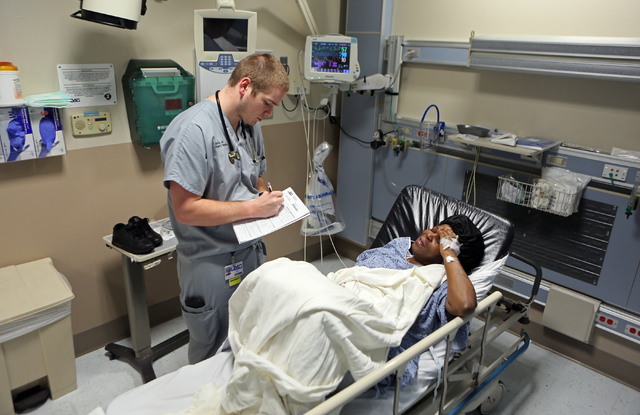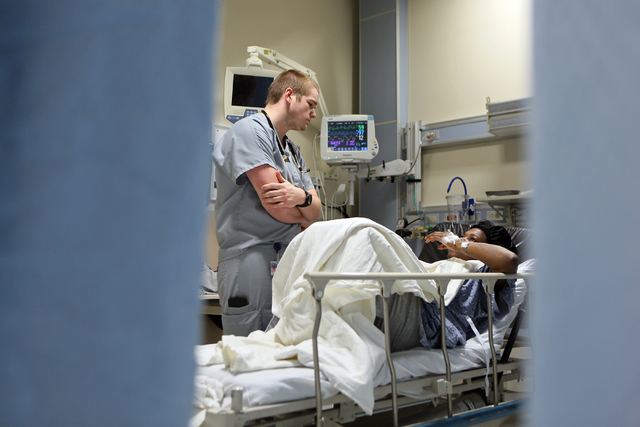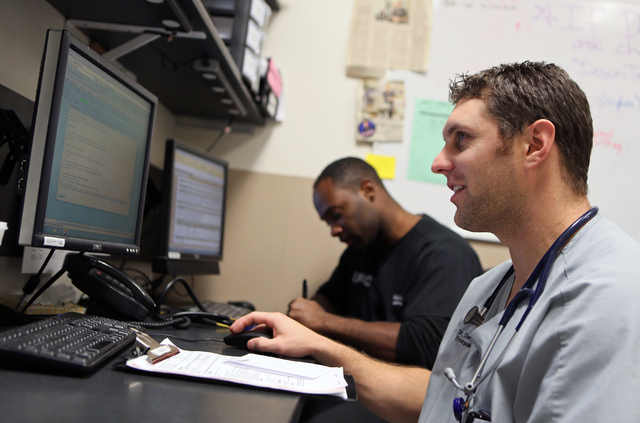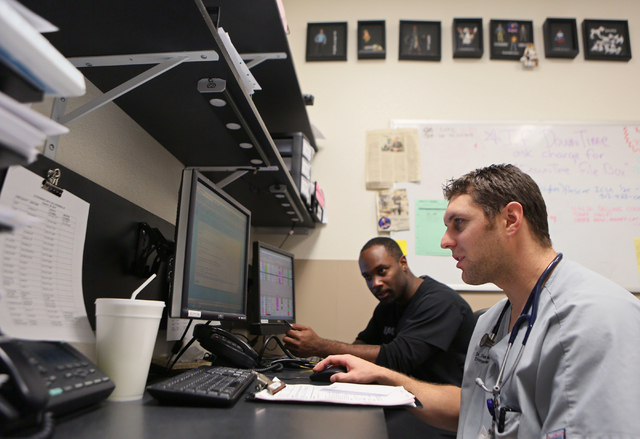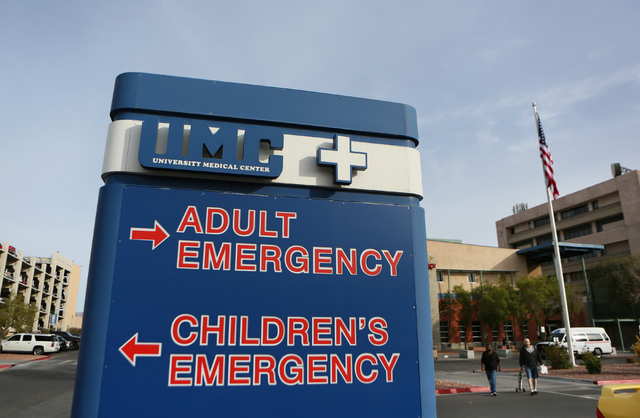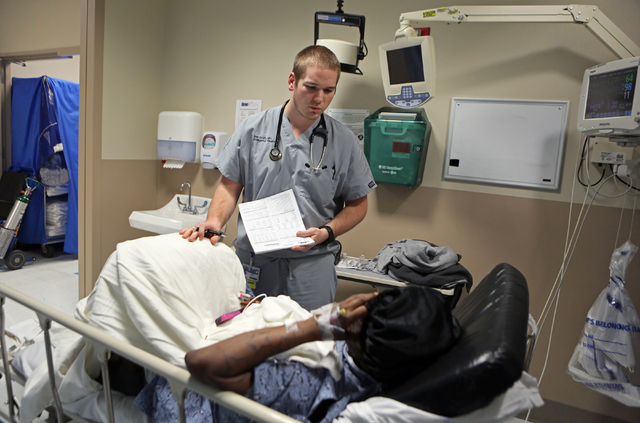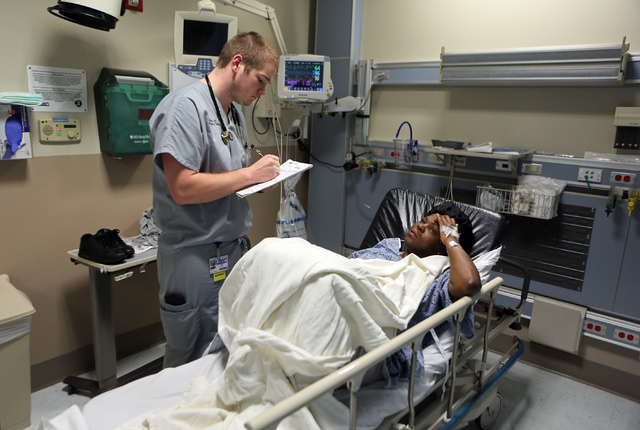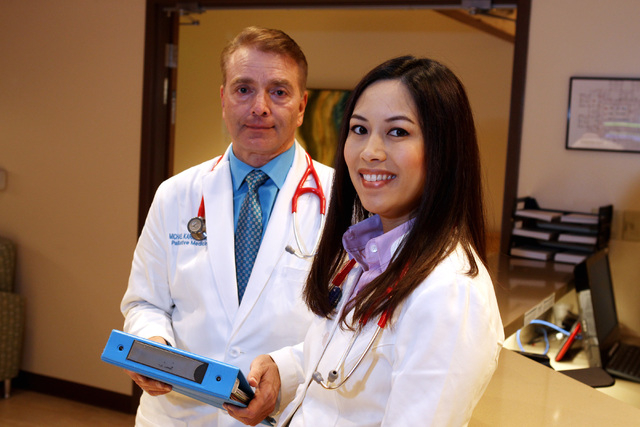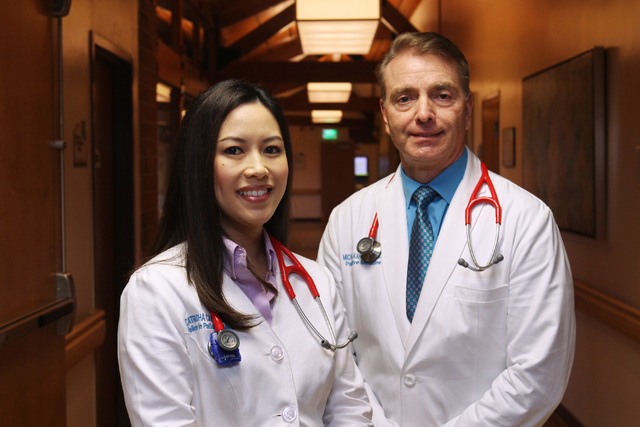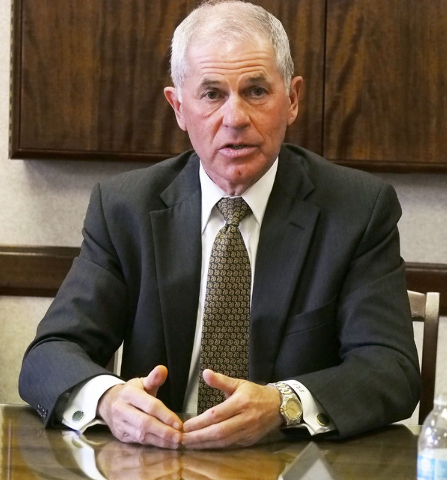Sandoval’s med plan seen as step toward boosting Nevada’s doctor count
The $10 million Gov. Brian Sandoval has proposed for residency training for medical school graduates is being hailed as a crucial boost to improve Nevada’s ratio of doctors per capita, often the key statistic when states are rated for quality of health care.
The final element of Sandoval’s plan to bolster education in Nevada was a first-of-its-kind budget proposal aimed at shortening the time patients wait to see doctors, delays that can last for weeks or even months. The money budgeted for graduate medical education was only a fraction of the $882 million in education spending Sandoval touted in his State of the State address, but the proposal has the potential to create programs for training that could cut Nevada’s physician shortage.
The proposal culminates years of effort by health care providers, medical school officials, hospital executives and patient advocates to increase the number of physicians working in Nevada.
Graduate medical education in the form of residency and fellowship training comes after medical school and is required before a physician can practice. The state where doctors complete that training often dictates where they set up shop.
Besides helping meet the existing need for doctors, two new medical schools eventually will be graduating physicians looking to complete their training. With new programs being created at MountainView Hospital in Las Vegas and Renown Health in Reno, Nevada is positioned as never before to offer residency opportunities to newly minted doctors.
Public perception often equates establishing a new medical school with addressing the physician shortage, but the process is not complete without opportunities for graduate medical education.
“It would not matter if Nevada created one new medical school or 20 new medical schools, we still won’t be able to create a single physician for the state. This was the major piece,” said Shelley Berkley, CEO and provost for Touro University Nevada, which graduates about 130 doctors of osteopathic medicine each year. “In Nevada, with our great lack of physicians, it’s incumbent upon us to take care of our own citizens. That’s what the governor understood, and that’s why he, very boldly and courageously, I believe, proposed funding of graduate medical education.”
Advocates for residency program funding have shifted their attention to the Legislature, where Sandoval’s proposal will be weighed against other state needs.
No lawmaker will be pushing for the proposal harder than state Sen. Joe Hardy. The Boulder City Republican, who maintains his family practice and serves as an associate professor at Touro, is one of the key players who laid the groundwork for the governor’s proposal.
On the federal level, Rep. Joe Heck, R-Nev., a doctor of osteopathic medicine specializing in emergency medicine, will continue working to leverage U.S. resources to bolster residency programs in the state.
LOOKING TO EXPAND
Hospital officials in Southern Nevada are examining how their facilities might be used to create additional programs, and health care advocacy groups are marshaling their efforts to lobby for the proposal. The most efficient use of the money might be creating programs at hospitals that never have had residents, because doing so could qualify for funding through the U.S. Centers for Medicare and Medicaid Services.
Whether that funding would become available is another matter.
“Let’s face it. There’s not going to be a significant increase in the Medicare dollars being utilized for graduate medical education,” Heck said. “Medicare is having a hard enough time keeping up with the dollars to pay for claims from beneficiaries, no less to fund graduate medical education.”
Therefore, Heck will focus on encouraging Medicare officials to reallocate money that is dedicated but not being used elsewhere in the country. The reallocation of money from vacant slots in 2003 led to the creation of the emergency medical program at University Medical Center. Heck also will reintroduce legislation that would authorize federal matching grants for new residency positions.
Such funding, if it became available, might be paired with money the Legislature could approve. Even without federal support, $10 million for graduate medical education could give Nevadans a big bang for their buck, proponents say. The programs at MountainView, for example, are being initiated with $2 million from the hospital’s parent company, HCA Healthcare.
New programs should be crafted on three criteria: community need, student demand and available resources, medical school and hospital officials say. If a certain patient population is being underserved and medical school graduates want to enter that field, that discipline could be the right fit for the creation of a residency or fellowship program, provided the initiation costs are within reason.
“There are some things we can do better than others,” said Dr. Thomas Schwenk, dean of the University of Nevada School of Medicine. “The question is: How does the state get the most for its money?”
Nevada graduates about 200 medical school students each year from Touro and the University of Nevada, but only about 100 residency positions are available annually, primarily at UMC, Valley and Sunrise Hospital and Medical Center. Students who don’t get in there must seek opportunities in other states, where they develop a community of colleagues and put down roots as they work to become fully licensed.
John Packham, health policy research director at the University of Nevada School of Medicine, said Nevada ranks 47th in the country in primary care providers per capita. The numbers for some specialists, especially in Clark County, fall below other Intermountain West states and the nation as a whole.
“The numbers surprised us a little bit,” Packham said.
For training doctors, the numbers are even more worrisome, said Dr. David Park, Touro’s chief academic officer for the residency program at Valley Hospital.
Nevada has 29 medical students per 100,000 people. When it comes to medical residents, the number is 12 per 100,000.
That disparity means many doctors-to-be are going through medical school in Nevada but receiving final training outside the state.
By comparison, U.S. averages are 30 medical students and 37 residents per 100,000, Park said.
Packham uses a 40-60-80 rule of thumb to illustrate how physicians decide whether to practice in Nevada. If students go to medical school and complete their graduate medical education in another state, they have a 40 percent chance of returning to Nevada to practice. All medical residents who complete their training in Nevada, whether they attended medical school here or elsewhere, have a 60 percent chance of staying.
However, of those students who complete both medical school and their residencies in Nevada, which Packham admits is a relatively small number, 80 percent hang their shingles in the state.
BACKING THE BUDGET
Sandoval’s proposal is among the legislative priorities of several groups, including the Nevada Hospital Association, Health Insight Nevada, the Clark County Medical Society and the Nevada Health Care Association, which promotes the interests of long-term care facilities.
“Everybody is convinced that kind of program in Southern Nevada will improve health care as a whole in the state,” said Daniel Mathis, president and CEO of the Nevada Health Care Association.
Las Vegas HEALS, a nonprofit organization committed to improving access and delivery of medical care in Southern Nevada, organized a meeting in June 2013 bringing together medical school officials, representatives for health care providers and executives from hospitals and HMOs. That meeting led to the creation of two panels, including a task force led by Hardy and Schwenk, which made recommendations late last year that formed the basis for Sandoval’s proposal.
“It’s a great first step, but we have to find other sources of support, including hospital support, to take advantage of this,” Schwenk said. “Hospitals need to rethink where graduate medical education fits into their strategic vision.”
Those discussions already are happening in companies with Southern Nevada hospitals.
The fate of the graduate medical education proposal will be watched closely by officials at Dignity Health Nevada, said Brian Brannman, senior vice president of operations. Dignity Health has hired consultants to look at what residencies might be suited for its three hospitals, and the nonprofit’s officials have talked about supporting the planned medical schools at UNLV and Roseman University of Health Sciences, Brannman said.
UNLV and Roseman plan to have 60 medical school graduates per year starting in 2021.
“A lot of it could be based here,” Brannman said from the St. Rose Dominican Hospital, Siena campus. “We’ve expanded our inpatient rehabilitation facility at de Lima. That would be a very good candidate to start a residency program in rehabilitative medicine. Family medicine or OB/GYN might work at San Martin or Siena. We’re open to using the entire system. It depends on which specialties really fit.”
At Universal Health Services, officials are studying whether Summerlin, Desert Springs or Spring Valley hospitals would be well-suited for residency programs, said Valley Hospital CEO Sam Kaufman, a task force member. Besides meeting the need for doctors, the new medical schools will require residents to help train students in their third and fourth years when they need clinical experience in a hospital setting, Kaufman said.
Retaining and attracting physicians to the state also has a financial effect because the economic ripples of each doctor in Nevada can average $1 million directly from the practice and the jobs multiplier from associated businesses, said Vance Farrow of the governor’s office of economic development.
Some 100,000 people are employed in health care in Nevada, generating $5.5 billion of economic activity. Although the governor recognizes the potential economic benefit, Farrow said, the main goal is to speed the increase of the number of physicians practicing in Nevada, especially primary care doctors and psychiatrists.
When discussing the governor’s proposal, supporters tout the benefits Nevadans will enjoy from having more access to health care providers.
Hardy said he often hears constituents complain about waiting weeks to see a primary care doctor or months for a specialist, and the situation could get worse. With more people seeking care through the Affordable Care Act and the recent Medicaid expansion, tens of thousands of new patients need to see a primary care provider.
Hospitals starting residency programs will enjoy the benefits of converting into a teaching institution. Brannman, the former CEO of UMC, said he was drawn to the county hospital because of the teaching component, and that’s why Dignity Health is reaching out to the planned medical schools.
“You have a lot of intense scholarly activity, which means the faculty and students are staying up to date on the most recent innovations in health care and the most recent research,” he said. “They need to be doing scientific, clinical and transnational research, and that could change the dynamic of health care in Las Vegas.”
“This is an investment in the future,” added Dr. Mitchell Forman, the founding dean at Touro. “Quality health care means that you have in place a system that is able to sustain itself, that you have oversight, that it’s collaborative, that involves both the private and public sectors.
“We will attract all the best people from all over the country. There will be people coming from other places because this is a quality place to receive your graduate medical education.”
Contact Steven Moore at smoore@reviewjournal.com or 702-380-4563.
DOCTOR TRAINING UNMASKED
By the time prospective doctors graduate they have completed years in college and four years in medical school, which teaches broad curative and healing knowledge and basic clinical skills. Upon graduation, students receive a degree of either medical doctor, or MDs, or doctor of osteopathic medicine, DOs, and they have earned the title of doctor.
The first stage of graduate medical education is residency within a specific branch of medicine from family practice to anesthesiology to obstetrics and gynecology to radiation oncology. Doctors often become licensed after their first year of residency, but Nevada requires at least two years. After residency, a physician might continue his or her training in a fellowship for a specialty such as gastroenterology or pulmonology, both of which are offered at Valley Hospital and UMC.
Fellowships offered through the University of Nevada School of Medicine at UMC include acute care surgery, colon and rectal surgery, and hand and microsurgery. Officials with Touro University Nevada and Nathan Adelson Hospice recently created a fellowship in hospice and palliative medicine, which eventually will provide slots for three fellows to train in providing relief of suffering and end-of-life care.
The goal of physician training is to have attending doctors training residents and residents teaching medical students.
"We need to create additional GME programs and bring on another 85- or 100-slot program here or another 85- or 100-slot program there," Valley Hospital CEO Sam Kaufman said. "Those medical schools are going to have GME needs down the road once they start graduating their students. In the third year and fourth year of medical school, that’s where the training of the med students starts to occur in the hospitals."



